English Muffins - Sourdough and a regular version!
I’ve been making English muffins for the boys school lunches lately. We turn them into mini pizzas or use them for sandwiches. Or we eat them for breakfast, toasted with butter. English muffins aren’t baked like normal bread, instead they’re cooked in a pan on both sides to create a crisp outer but have a lovely soft texture inside. If you open an English muffin the traditional way (prick it all around with a fork and tear it open), you get all these lovely nooks and crannies, perfect for butter to hold on to!
I mostly make them sourdough, but if I’m short on time, I use instant yeast. I’m sharing both recipes today, though they’re essentially the same except for the swap of yeast and timings. The sourdough version undergoes a cold-proof to bring extra flavour and texture. The timings of the cold proof can be tweaked to fit around your schedule so you can cook em when you’re ready.
I make the sourdough version by hand and use stretch and folds, but for the regular yeast version I use my stand mixer. There’re no real reason for that - I just think with sourdough I am prepared for things to take longer and I enjoy the slower process. If you want to mix the sourdough version in a stand mixer too, you absolutely can. The same goes the other way - you can stretch and fold the regular yeast dough, and give it an overnight cold-proof for extra flavour just like the sourdough version if you like.
Sourdough English Muffins
You can find the printable version on Home Grown Happiness.
Sourdough starter
25 g sourdough starter
50 g all-purpose flour
50 g water
Dough
120 g water
120 g milk
30 g unsalted butter, melted
All the sourdough starter (around 100g active starter)
20 g granulated sugar
375 g all-purpose flour
5 g salt
Dusting
Semolina or cornmeal for dusting (optional)
Method
In the morning feed your sourdough starter. In a bowl, mix all the starter ingredients until well combined. Scoop the mixture into a clean jar and cover it with a loose lid. Leave it in a warm place to double.
When the starter has doubled, begin the dough.
In a large bowl add water, milk, melted butter, sourdough starter and sugar and give it a whisk with a fork to combine it. The starter won't combine properly yet.
Add the flour and salt and use a fork to combine them. Switch to using your hands and push the dough into a shaggy and sticky dough mound. It won't be smooth yet, but ensure everything is well combined.
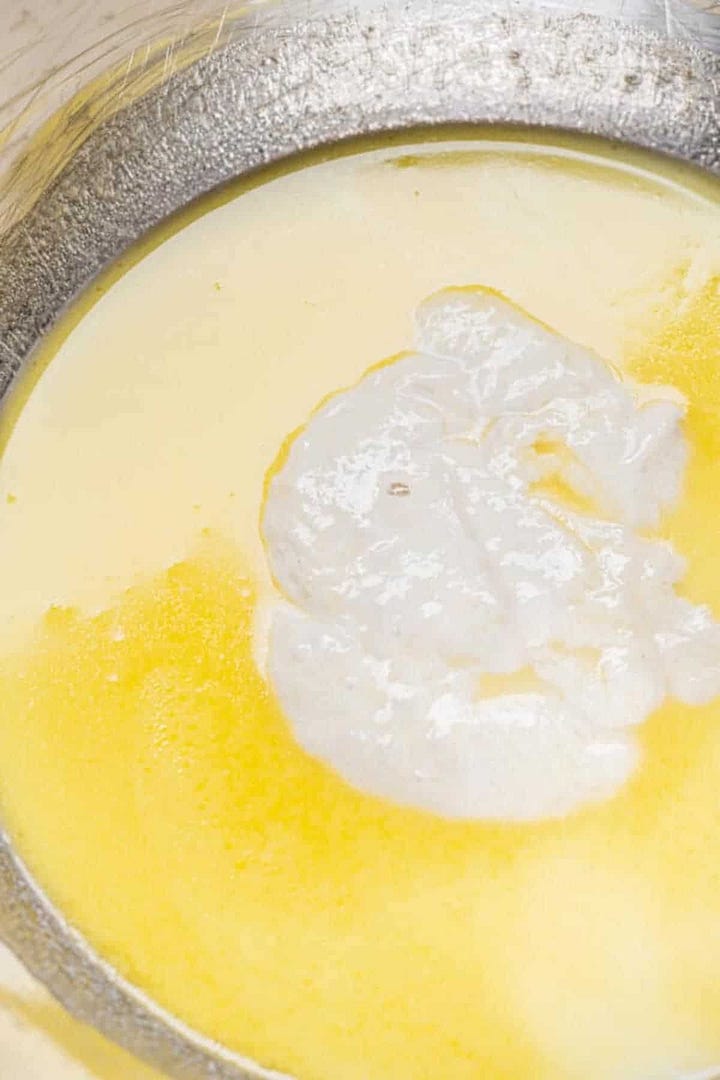
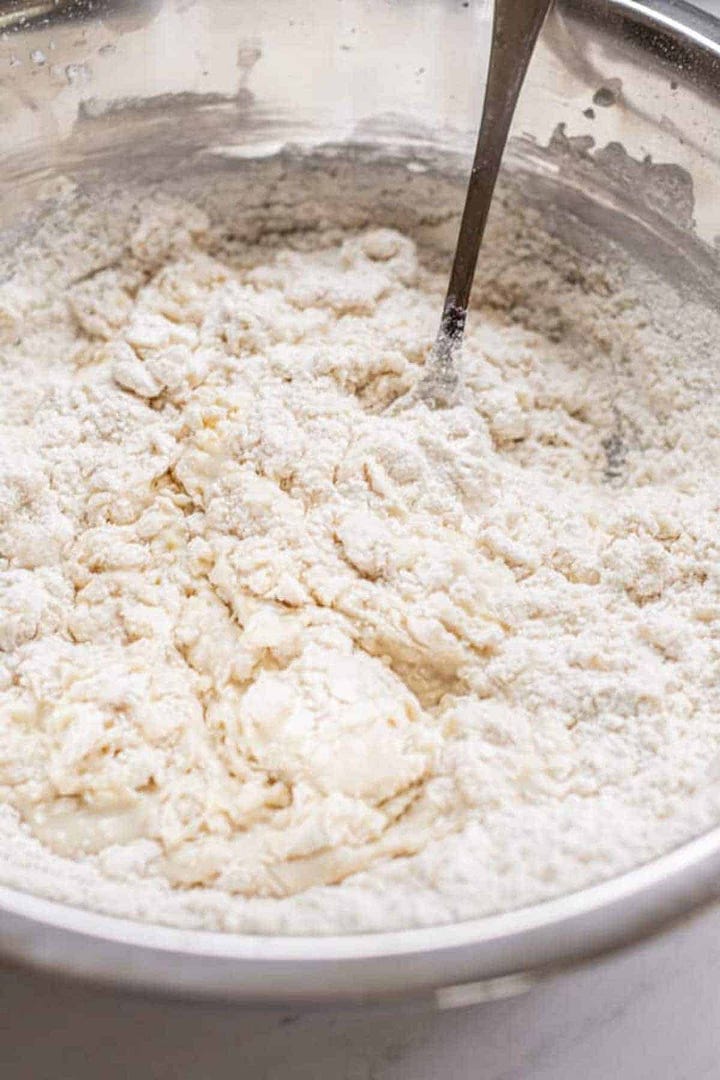
Place the dough ball in a clean, large bowl and give it a stretch and fold. Cover the bowl with a damp tea towel or plastic wrap and place it in a warm place. Over the next hour, give the dough another 3 sets of stretch and folds, spaced around 20 minutes apart.
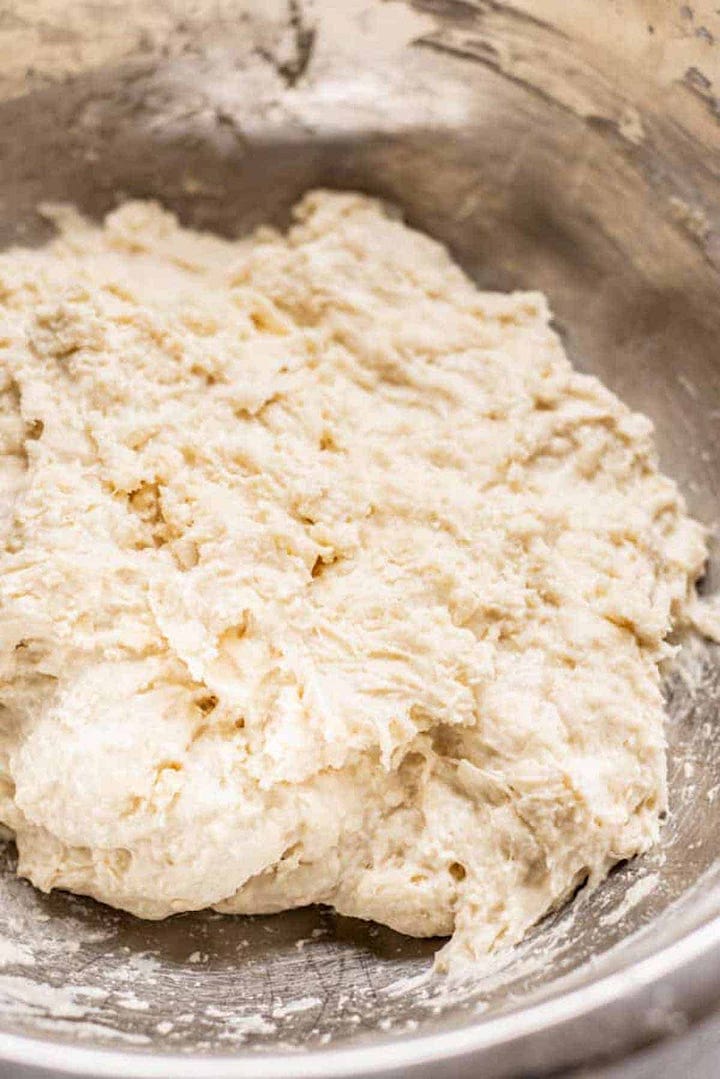

After the hour, let the dough rise in the warm spot for another 3-4 hours, ideally around 77°F/25°C) until puffed out by around 40%. If you have a cold kitchen, create a warm and humid spot by placing the dough into a turned-off oven alongside a bowl of boiled water. Replace the water as needed when it cools down.
Cold Proof
Once risen, cover the bowl tightly and place it in the fridge overnight or for up to 2 days.
Shaping
Take the cold dough from the refrigerator and pull it from the bowl onto a lightly floured surface. Let it sit at room temperature for around 10 minutes to relax.
Use a rolling pin or your fingers to push the dough into a 2cm (just under 1 inch) round.
Cut out dough circles with a glass or biscuit cutter that measures around 7.6 cm/3 inches in diameter. and place them on a semolina/corn meal or flour dusted surface. Lightly dust the top of the dough circles with cornmeal or semolina. Alternatively, divide the dough into 10 equal portions. Gently roll each portion into a smooth ball. Press each ball into a flat, round disc about 3/4 inch thick.
Any scraps of dough can be gathered up and rolled again. Let the dough rest and relax first before rolling it out so it doesn't spring back too much.

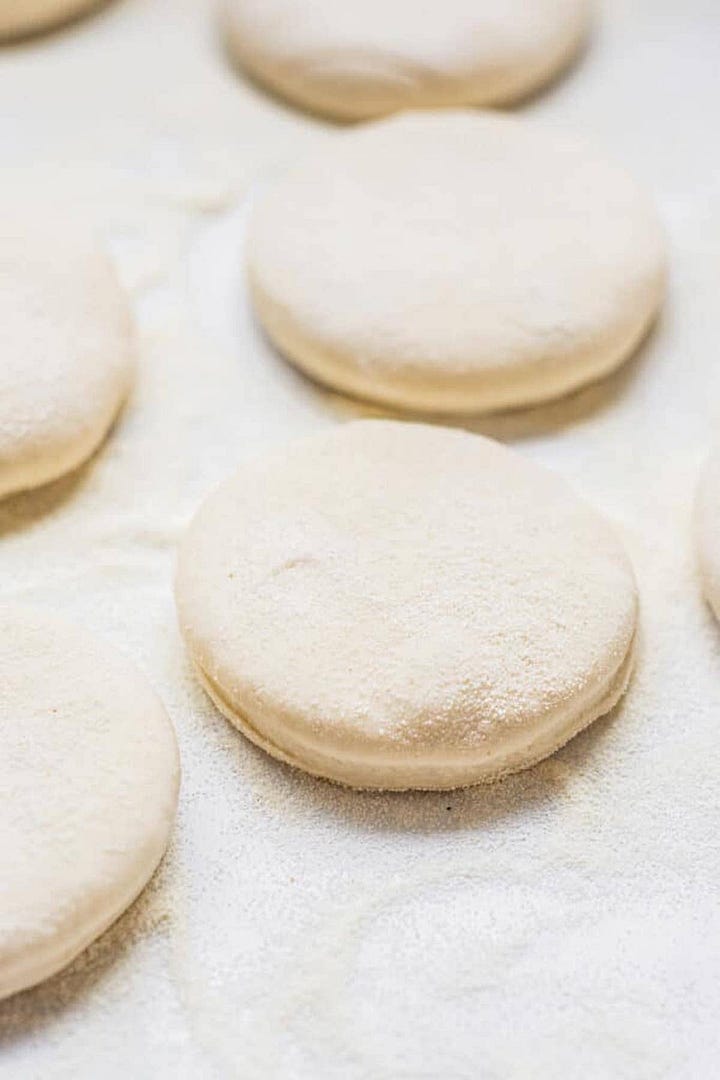
Let the dough rounds sit at room temperature for around an hour to puff. At the end of the rising time, preheat a cast iron pan or nonstick skillet over low-medium heat.
Cooking
Place 4 muffins in the pan and cook on one side for 6-7 minutes. If your pan has a lid, add this on and it will shorten the time to around 5 minutes.
Flip the muffins and cook for 5-6 minutes on the other side. You may need to play around with the temperature of your stovetop to get it right. If medium-low is too hot, turn it down to low heat. It should be hot enough to create a deep golden brown toasted exterior but not too hot to burn. If you have a thermometer, the internal temperatures of the muffins should read 200°F/94°C.
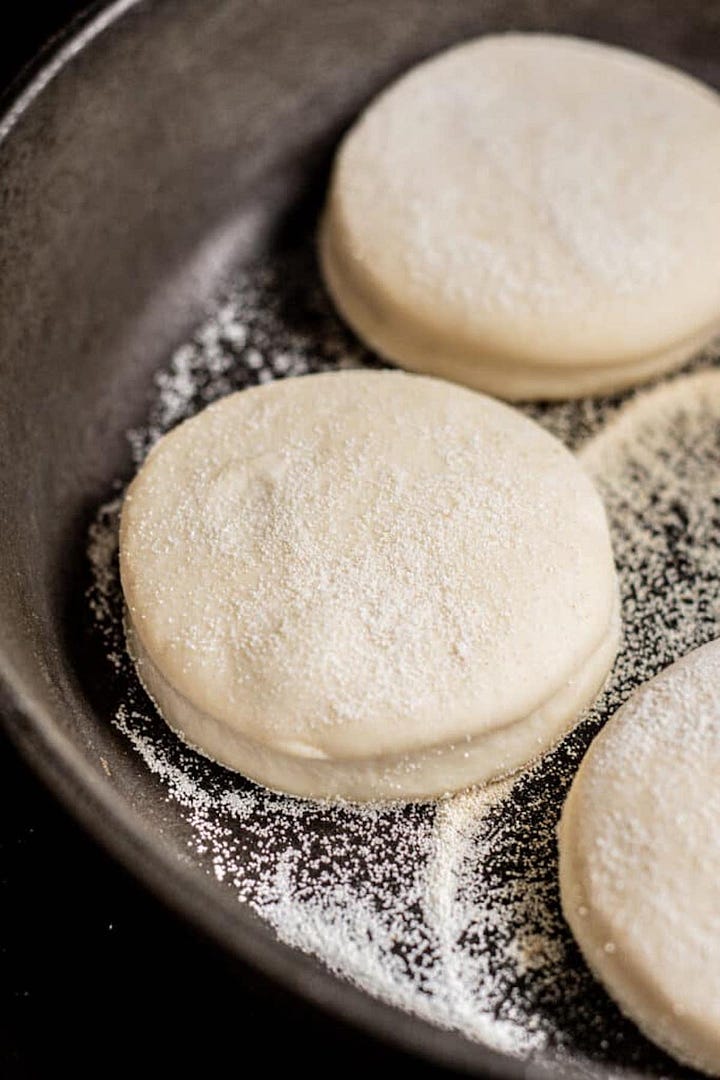
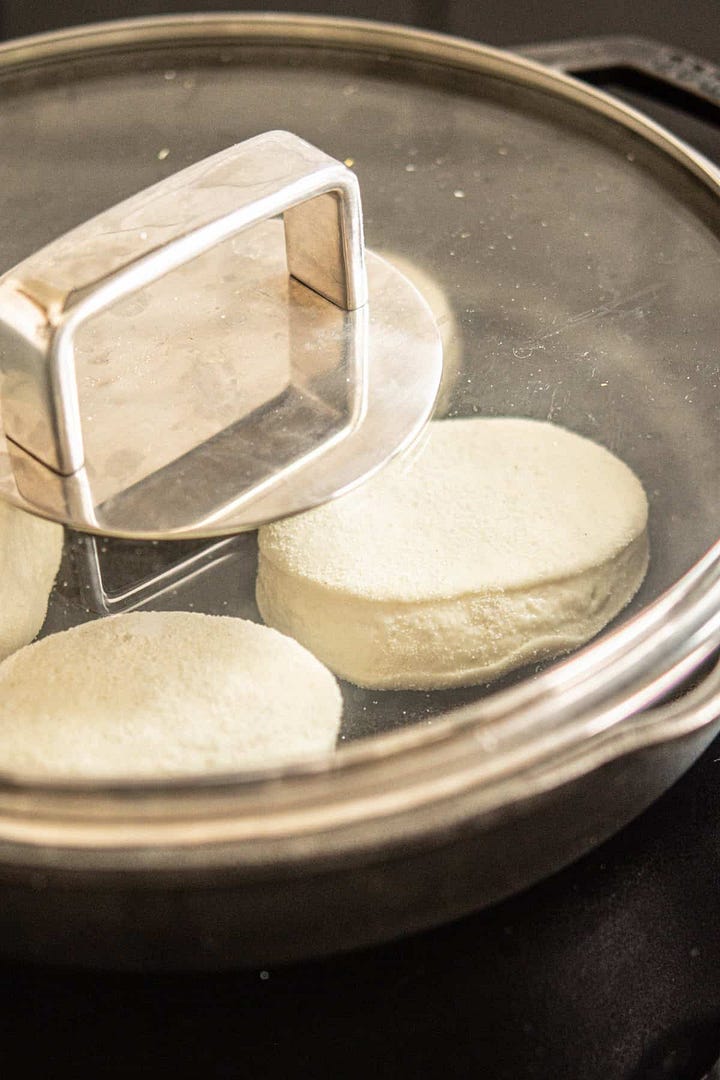
Place the cooked muffins on a wire rack to cool while you cook the remaining muffins. Dust away semolina flour from the pan before adding the next batch, or it will burn.

Regular English Muffins
120 g water (1/2 cup)
120 g milk (1/2 cup)
30 g (2 tablespoons) unsalted butter, melted
7g (2 teaspoons) instant yeast
20 g (2 Tablespoons) granulated sugar
375 g all-purpose flour (around 3 US customary cups)
5 g (1 teaspoon) salt
Dusting
Semolina or cornmeal for dusting (optional)
Method
Add all the dough ingredients to a large bowl or the bowl of a stand mixer fitted with a dough hook.
Mix or knead the dough for around 8 minutes until soft and smooth. Add to a clean bowl and cover with a lid or damp towel. Let it rise until doubled in size.
Punch down the dough and pull it onto a lightly floured work surface.
Push the dough out with your finger tips until it's around 3/4 inch (2cm thick). Use a round cookie cutter (3-4 inches in diameter) to cut out circles from the dough. Alternatively, divide the dough into 10 equal portions. Gently roll each portion into a smooth ball. Press each ball into a flat, round disc about 3/4 inch thick.
Lightly dust each side of the disc or dough circle with cornmeal or semolina. Let them rise another 30 minutes until lightly puffed.
Cooking
At the end of the rising time, preheat a cast iron pan or nonstick skillet over low-medium heat. Place 4 muffins in the pan and cook on one side for 6-7 minutes. If your pan has a lid, add this on and it will shorten the time to around 5 minutes.
Flip the muffins and cook for 5-6 minutes on the other side. You may need to play around with the temperature of your stovetop to get it right. If medium-low is too hot, turn it down to low heat. It should be hot enough to create a deep golden brown toasted exterior but not too hot to burn. If you have a thermometer, the internal temperatures of the muffins should read 200°F/94°C.
Place the cooked muffins on a wire rack to cool while you cook the remaining muffins. Dust away semolina flour from the pan before adding the next batch, or it will burn.

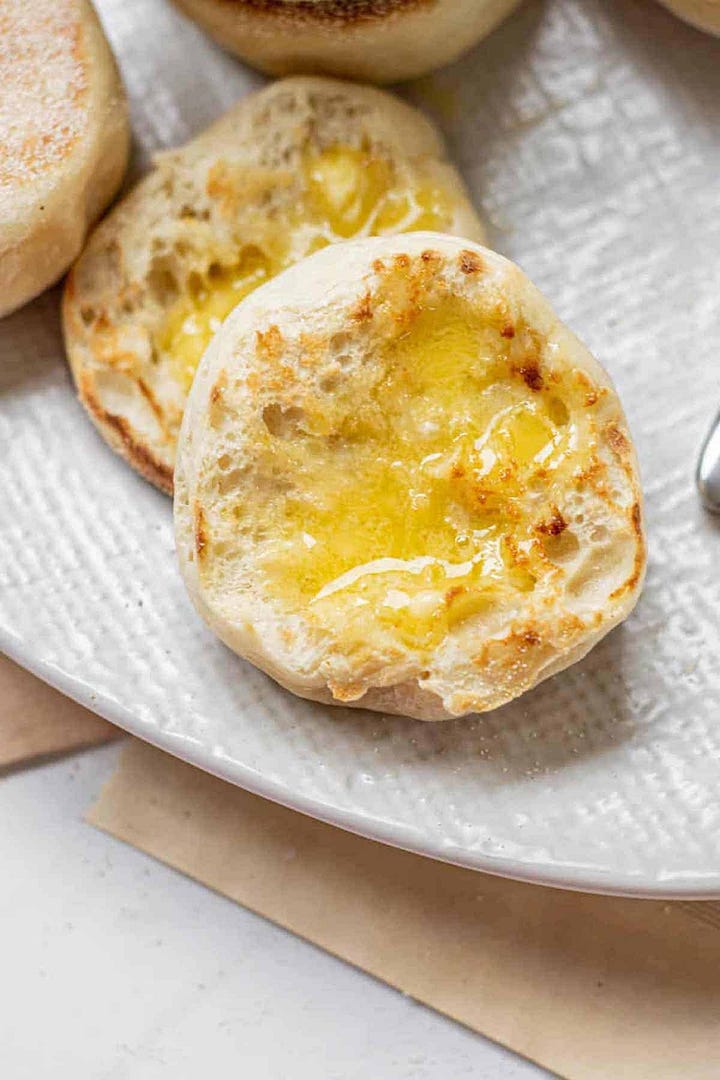
Happy cooking!



